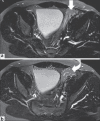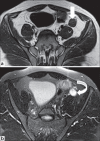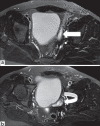Persistent mullerian duct syndrome
- PMID: 20352001
- PMCID: PMC2844757
- DOI: 10.4103/0971-3026.59761
Persistent mullerian duct syndrome
Abstract
Persistent Mullerian duct syndrome (PMDS) is a rare form of internal male pseudohermaphroditism in which Mullerian duct derivatives are seen in a male patient. This syndrome is characterized by the persistence of Mullerian duct derivatives (i.e. uterus, cervix, fallopian tubes and upper two thirds of vagina) in a phenotypically and karyotypically male patient. In this article we present the USG and MRI features of a case of PMDS with bilateral cryptorchidism and left sided inguinal hernia, containing the uterus and fallopian tubes.
Keywords: Cryptorchidism; MRI; USG; inguinal hernia; mullerian duct derivatives; mullerian inhibiting factor; pseudohermaphroditism.
Conflict of interest statement
Figures





Similar articles
-
Male form of persistent Mullerian duct syndrome type I (hernia uteri inguinalis) presenting as an obstructed inguinal hernia: a case report.J Med Case Rep. 2011 Dec 20;5:586. doi: 10.1186/1752-1947-5-586. J Med Case Rep. 2011. PMID: 22185203 Free PMC article.
-
A Rare Case Report of Inguinal Hernia with Persistent Mullerian Duct and Klinefelter Syndrome.J Clin Diagn Res. 2016 Jun;10(6):PD28-9. doi: 10.7860/JCDR/2016/18361.8050. Epub 2016 Jun 1. J Clin Diagn Res. 2016. PMID: 27504355 Free PMC article.
-
Combined persistent Mullerian Duct Syndrome, Transverse Testicular Ectopia and Mosaic Klinefelter's Syndrome.J Coll Physicians Surg Pak. 2008 Jun;18(6):375-7. J Coll Physicians Surg Pak. 2008. PMID: 18760051
-
Persistent Mullerian duct syndrome: a case report and review of the literature.Afr J Paediatr Surg. 2010 Sep-Dec;7(3):191-3. doi: 10.4103/0189-6725.70425. Afr J Paediatr Surg. 2010. PMID: 20859029 Review.
-
Persistent Müllerian Duct Syndrome (PMDS): a Rare Anomaly the General Surgeon Must Know About.Indian J Surg. 2015 Jun;77(3):217-21. doi: 10.1007/s12262-013-1029-7. Epub 2014 Jan 3. Indian J Surg. 2015. PMID: 26246705 Free PMC article. Review.
Cited by
-
Male form of persistent Mullerian duct syndrome type I (hernia uteri inguinalis) presenting as an obstructed inguinal hernia: a case report.J Med Case Rep. 2011 Dec 20;5:586. doi: 10.1186/1752-1947-5-586. J Med Case Rep. 2011. PMID: 22185203 Free PMC article.
-
Persistent Mullerian duct syndrome: rare presentation in an elderly man.BMJ Case Rep. 2020 Jul 16;13(7):e234890. doi: 10.1136/bcr-2020-234890. BMJ Case Rep. 2020. PMID: 32675118 Free PMC article.
-
Novel homozygous mutation in a colombian patient with persistent müllerian duct syndrome: expanded phenotype.Int Braz J Urol. 2019 Sep-Oct;45(5):1064-1070. doi: 10.1590/S1677-5538.IBJU.2018.0808. Int Braz J Urol. 2019. PMID: 31184456 Free PMC article.
-
Persistent mullerian duct syndrome in a patient with bilateral cryptorchid testes with seminoma.J Hum Reprod Sci. 2012 May;5(2):215-7. doi: 10.4103/0974-1208.101025. J Hum Reprod Sci. 2012. PMID: 23162363 Free PMC article.
-
Incidentally Discovered Persistent Müllerian Duct Syndrome in a 45-year-old male presenting with germ cell tumor and bilateral cryptorchidism: A rare case report and review of the literature.Int J Surg Case Rep. 2018;43:41-44. doi: 10.1016/j.ijscr.2018.02.002. Epub 2018 Feb 9. Int J Surg Case Rep. 2018. PMID: 29453163 Free PMC article.
References
-
- Yuksel B, Saygun O, Hengirmen S. Persistent müllerian duct syndrome associated with irreducible inguinal hernia, bilateral cryptorchidism and testicular neoplasia: A case report. Acta Chir Belg. 2006;106:119–20. - PubMed
-
- Gutte AA, Pendharkar PS, Sorte SZ. Transverse testicular ectopia associated with persistent Mullerian duct syndrome – the role of imaging. Br J Radiol. 2008;81:E176–8. - PubMed
-
- Dekker HM, de Jong IJ, Sanders J, Wolf RF. Persistent mullerian duct syndrome. Radiographics. 2003;23:309–13. - PubMed
-
- Clemente A, Macchi V, Berretta M, Morra A. Female form of persistent müllerian duct syndrome: MDCT findings. Clin Imaging. 2008;32:314–7. - PubMed
-
- Wu HC, Chen JH, Lu HF, Shen WC. Persistent mullerian duct syndrome with seminoma. AJR Am J Roentgenol. 2000;174:102–4. - PubMed
Publication types
LinkOut - more resources
Full Text Sources

